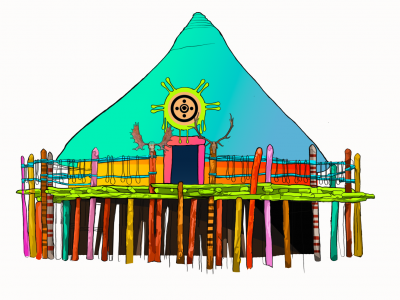
Dr [M] Dudeck is a performance artist and queer theologian whose work explores the role played by art and the speculative imaginary in the construction of new belief systems. For the past fifteen years they have devoted themselves to the invention and dissemination of a fictional queer religion and gnostic space opera called RELIGIONVIRUS (http://religionvir.us), whose transmedial episodes have been performed, screened and exhibited in over 35 countries worldwide. As a theologian and scholar of religion they publish and lecture widely on the intersection of art, religion, and speculative fiction in the information age. Dudeck is the co/director (alongside of Martina Raponi) of the Ansible Institute -- a nomadic research laboratory for artists using speculative fiction to imagine new futurities -- as well as curator of the online video festival RUINS (http://ruins.digital) probing the intersection of religion and contemporary media art, commissioned by the British Association for the Study of Religion (BASR).
As an artist, I have spent the past fifteen years inventing my own queer religion as art, and as a scholar of religion I explore the role played by art, and the speculative imagination on new forms of religion in the information age. For my IASH-CTPI Duncan Forrester Fellowship, I have partnered with a living history museum in the Scottish Highlands called the Scottish Crannog Centre, bringing contemporary new media artists to interface with experimental archaeologists in conceiving of new rituals for the post/future. I have invited eight artists over a period of four months to come up to the Crannog Center to interface with the living history museum.
A 'Crannog' is an artificially constructed iron-age dwelling that was built atop shallow lakes, and the Crannog Center is re-constructing three of these structures on the banks of the freshwater river Loch Tay. These three Crannogs are part of a much larger reconstructed Iron Age Village, replete with a Celtic Roundhouse, a blacksmith's forge, earth ovens and hearth for cooking, a weaving station, a pottery station, wood-carving and stone masonry stations as well. The Museum is open 7 days a week and members of the public are invited to experiment in methods used in the Iron Age, by those inhabitants of the region who lived and wove stories inside these Crannogs. Experimental Archaeology examines the ruins and material remains of prehistory and attempts to learn about them through making, fabricating and testing out methods in an experimental and artistic process.
I have thus far identified that many of the aims of public art and public archaeology are symbiotic, and synthesize to produce new forms of religiosity in members of the general public. The initial success of the research/process has inspired me to produce a much larger project – a multi-year festival called NEOLITHIC TRANSMITTERS that brings artists and archaeologists together to design new rituals in ancient sites.
